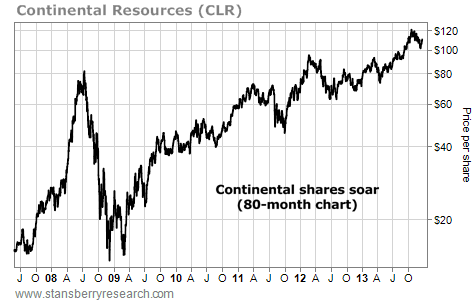| Home | About Us | Resources | Archive | Free Reports | Market Window |
|
Editor's note: Today, we're continuing our series on the most important financial steps for you to take in 2014. You can find previous essays here and here. Print these ideas out and keep them close. They'll serve you well in the new year.
Top 2014 Money Moves:
Our Favorite Precious-Metals TradeBy
Thursday, December 26, 2013
Among the most important financial decisions you'll ever make is the decision to buy precious metals like gold and silver.
At Stansberry & Associates, we have been urging investors to buy precious metals for more than 10 years. We own precious metals ourselves. We've even published books on the right ways to invest in them.
But we see precious metals like gold and silver differently than most financial professionals…
We don't see them as conventional investments. We see them as money. We see them as real, intrinsic wealth. We don't buy precious metals to grow our wealth. We buy them to have wealth.
We also see precious metals as good "oh crap" insurance to hedge ourselves against a big crisis in the world's monetary system.
From 2002 to 2011, gold climbed from $300 per ounce to $1,900 per ounce. Since then, gold has experienced a natural correction down to $1,250 an ounce.
If you've never bought precious metals before, we see the recent correction as a good place to buy a few ounces. We also see a big opportunity to buy a certain precious metal that you've likely never considered before...
The precious metal we're talking about is platinum.
Part of the case for owning platinum is the familiar case for owning gold: World governments aren't solvent, and they're competing with each other to devalue their currencies. That's good for precious-metal prices in the long term.
But we like platinum in particular because of the supply-demand setup.
Platinum production is falling in the world's biggest producer – South Africa. Producers in the country aren't earning enough money to cover basic expenses. This situation curtails production... which will push up prices.
Unlike gold, there isn't a large above-ground supply of platinum. Most platinum production is consumed by industry (much of it in smog-reducing catalytic converters). Meanwhile, both developed and developing countries are putting stricter emissions standards in place... And that's increasing demand.
It's not too late to make this trade, though. Like most commodities, platinum has suffered a big fall from its 2011 highs. Right now, it trades near four-year lows.
_KV54J1BA0P.png) Some folks might want to trade this idea with a purchase of platinum mining stocks… But the world of pure platinum miners is small... and full of "less than exceptional" businesses. You face the risks of worker strikes, mine accidents, political lunacy, and rising input costs.
So we're more comfortable with physical platinum – or a fund that moves with the price of physical platinum.
In sum, a position in physical platinum works as a hedge against a drop in the value of "paper money." Plus, the platinum market is vulnerable to a major supply shock. That could send prices higher, even if a monetary crisis never arrives.
That's why we believe it makes sense to take a position in platinum right now.
Good investing,
Brian Hunt
Further Reading:
Dr. David "Doc" Eifrig has shown readers how powerful it can be to hold "chaos hedges" – like gold – in your portfolio... "When investors get nervous about bad economic news... debt crises in Europe... and the specter of runaway inflation in the United States," he writes, "stocks fall, and gold and silver rise." Learn how Doc protects his wealth with precious metals here and here.
Classic interview: "Gold is not an investment, and has never been an investment," Doug Casey says. "I consider gold to be cash in its most basic form, much more so than the U.S. paper currency we currently call money." Find out why gold is the "real" money here.
Market NotesWHAT FINDING BILLIONS OF BARRELS OF OIL DOES TO YOUR SHARE PRICE Remember... we're celebrating year's end by highlighting important facets of the huge North American oil and gas boom. Each day this week, we're showing you how surging energy production is shaping our world.
Of all the new areas of production, few are as celebrated as North Dakota's Bakken Shale. Although development of this field is relatively new, it's already one of America's largest-producing fields. It allows North Dakota to sport the country's lowest unemployment numbers and a government budget surplus.
The biggest player in the Bakken is an energy company named Continental Resources (CLR). Continental was a pioneer in utilizing the game-changing drilling technologies we mentioned on Monday. In 2004, it was the first company to successfully horizontally drill and fracture one of its wells.
After going public in May 2007, shares took off. They rose nearly 400% in just over a year… only to get slammed back down with the rest of the market. But since March 2009, Continental shares have rocketed more than 650%. They recently hit new all-time highs. Finding billions of barrels of oil will do that…
 |
In The Daily Crux
Recent Articles
|


